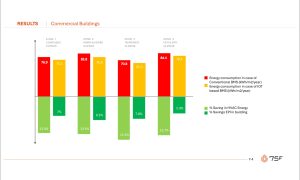75F identified a tiny bug in our 75F® Central Control Unit™ software causing an edge case.
Early this summer, a small Georgia elementary school with approximately 400 students installed 75F’s IoT-based Building Management System. During the warm summer and early fall months, occupants were happy with the improvements to their building. Once outside temperatures began to drop, however, people at the school immediately noticed a problem: Temperatures in the building were swinging between too hot and too cold. At 1 p.m. on a Friday, school facility management reached out to Kenny — an experienced project engineer on our team — with the issue. By Monday morning, 75F identified a tiny bug in our 75F® Central Control Unit™ software causing an edge case (or difficult-to-replicate error in specific environments), and developed, tested, and deployed a hotfix that both solved the issue at the school and ensured no other sites would experience the same problem.
All of this transpired over 36 hours before students even came back from the weekend, and it’s a prime example of how IoT-based building automation transcends the norm in this industry. What does “the norm” look like here? Let’s examine what would have happened at this elementary school if 75F were a different company.
TIME. MONEY. SWEAT.
No matter the type of building controls solution installed, the first order of business when responding to a customer complaint is troubleshooting. With a traditional controls solution, it’s likely building management at the elementary school were the only ones with access to building data. If this data were trended, school management may be able to export it and share with their installing contractor for analysis.
More likely, building systems data would only be available on site and not in a trended format, so the contractor would need to get in their truck, drive to the school, and watch the data run in real time to understand what’s going wrong with the system. School facility managers would need to schedule the site visit with the installing contractor, and accomplishing this first step by Monday morning is highly unlikely.
Next, the contractor would need to determine a course of action. If the issue was not configurable or tunable, they would contact the manufacturer’s support team for a solution. Meanwhile, people in the school would be paying in time, money, and discomfort for contractor and manufacturer site visits and continued temperature swings in the classroom.
Ultimately, it’s difficult to determine exactly how fast a problem like the one the elementary school experienced could be solved with a traditional BMS simply because the solution depends on so many different stakeholders. Is the school building data trended correctly, or at all? How fast can the installing contractor make it out to the building for their first visit? Will they need to involve the manufacturer, and if so, when will they be able to prioritize the solution? These dependencies collapse when the BMS is built on IoT.
A DIAGNOSIS IN 15 MINUTES, A SOLUTION IN A WEEKEND
When Kenny first heard from the elementary school on that Friday, he used 75F® Facilisight™to confirm within 30 seconds of taking the call that not only was there a comfort problem, but that it was much worse than the customer suggested. Temperatures were swinging 10 degrees every 30 minutes in an unusual cycle. Initial suspicions were that a combination of oversized equipment and thermostat placements next to discharge air from wall-mounted package units caused the disturbance, but preliminary investigations into the real-time and trended data in Facilisight disproved that theory.
When Kenny first heard from the elementary school on that Friday, he used 75F® Facilisight™to confirm within 30 seconds of taking the call that not only was there a comfort problem, but that it was much worse than the customer suggested. Temperatures were swinging 10 degrees every 30 minutes in an unusual cycle. Initial suspicions were that a combination of oversized equipment and thermostat placements next to discharge air from wall-mounted package units caused the disturbance, but preliminary investigations into the real-time and trended data in Facilisight disproved that theory.
Kenny roped in our director of support operations, Joe, and one of our software engineers, Samjith, to fix the problem. Within just 15 minutes of examining the site data, our team determined there was a blip in 75F’s control sequence that was causing our HyperStatto overshoot both desired heating and cooling temperatures, causing the units to rapidly cycle heating and cooling. As an edge case, we quickly determined this problem was only present in limited environments and was not affecting any other existing 75F users.
By Saturday, Samjith created a hotfix that both corrected the bug and tuned PI Loop control sequences to compensate for over-built equipment and the thermostats placed near discharge air, leaving school conditions better than they were before the issue arose. Early on Sunday morning, the 75F team remotely staged a brief dress rehearsal in the empty school to confirm that all systems were go, and then deployed the fix over the air. On Monday when students and staff arrived and the building returned to an occupied mode, the issue was completely resolved.
Cookie Consent
We use cookies to personalize your experience. By continuing to visit this website you agree to our Terms & Conditions, Privacy Policy and Cookie Policy.















